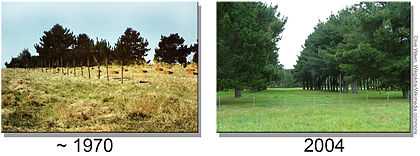Silvopasture

Silvopasture (Latin, silva forest) is the practice of combining forestry and grazing of domesticated animals in a mutually beneficial way. Advantages of a properly managed silvopasture operation are enhanced soil protection and increased long-term income due to the simultaneous production of trees and grazing animals. The trees are managed for high-value sawlogs and, at the same time, provide shade and shelter for livestock and forage, reducing stress and sometimes increasing forage production.[1]
Perhaps the oldest agroforestry system used in the temperate regions of the world, silvopastoral systems are characterized by integrating trees with forage and livestock production. Such systems have the potential to increase agricultural production in the long term.
Silvopastoral systems are definitely the most prominent agroforestry practice in the United States, particularly in the southeast.
In the UK, there is a nationwide experiment for silvopastoral systems in which a number of tree species and planting densities are being studied over a range of sites. It is called The Silvopastoral National Network Experiment.
Their experience shows that sheep use the trees for shelter from wind. This could provide significant animal welfare benefits. However the fact that the sheep do spend time close to trees results in greater soil compaction close to trees with the greatest compaction when trees are planted at very low densities. It is recommend that trees are planted at no less than 400 per hectare to ensure good establishment.
References
- ↑ "Silvopasture". National Agroforestry Center. National Agroforestry Center. Retrieved 29 April 2015.
- Venator, Charles R., Jurgen Glaeser and Reynaldo Soto. 1992. "A Silvopastoral Strategy" in Development or Destruction: The Conversion of Tropical Forest to Pasture in Latin America. pp. 281–292. Westview Press/Boulder
- The Farm Woodland Forum - Silvopastoral Agroforestry
External links
- National Agroforestry Center (USDA)
- Farm Woodland Forum - Silvopastoral Agroforestry
- The short film Agroforestry Practices - Silvopasture (2004) is available for free download at the Internet Archive